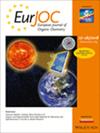单重态碳cs2加合物的机械化学解离
IF 2.5
3区 化学
Q2 CHEMISTRY, ORGANIC
引用次数: 0
摘要
由于单线态碳化合物的广泛应用,稳定加合物释放小分子生成碳化合物的研究日益引起人们的兴趣。本研究探讨了由三种不同的单线态碳烯(环(烷基)(氨基)碳烯(CAAC))组成的碳烯- CS2加合物对CS2的机械化学释放;N杂环碳(NHC);和N,N′-二胺苯(DAC)。在球磨条件下,这些加合物表现出明显不同的反应性;DAC-CS2在20分钟内完全释放CS2, NHC-CS2释放速度较慢,CAAC-CS2分解成复杂的混合物。DFT计算表明,CAAC-CS2释放CS2需要最高的活化能(32 kcal/mol),表明在反应条件下是不可接近的。这可能是因为CAAC的HOMO能量较高,与CS2的键更强,从而限制了它的解离。这项研究强调了碳烯的电子结构如何影响它们与小分子的相互作用,为控制碳烯-小分子加合物的反应性铺平了道路。本文章由计算机程序翻译,如有差异,请以英文原文为准。

Mechanochemical Dissociation of Singlet Carbene–CS2 Adducts
Owing to the extensive application of singlet carbenes, their generation through the release of small molecules from stable adducts is attracting increasing research interest. This study explores the mechanochemical release of CS2 from Carbene–CS2 adducts formed by three distinct singlet carbenes: cyclic (alkyl)(amino)carbene (CAAC); N‐heterocyclic carbene (NHC); and N,N’‐diamidocarbene (DAC). Under ball‐milling conditions, these adducts exhibit notably different reactivities; DAC–CS2 releases CS2 completely within 20 min, NHC–CS2 has a slower release rate, while CAAC–CS2 decomposes into a complex mixture. DFT calculations reveal that the release of CS2 from CAAC–CS2 requires the highest activation energy (32 kcal/mol), suggesting that it is inaccessible under the reaction conditions. This is likely because of the higher HOMO energy of CAAC, which correlates with a stronger bond with CS2, thereby limiting its dissociation. This study highlights how the electronic structures of carbenes influence their interactions with small molecules, paving the way for controlling the reactivity of carbene–small‐molecule adducts.
求助全文
通过发布文献求助,成功后即可免费获取论文全文。
去求助
来源期刊
CiteScore
5.40
自引率
3.60%
发文量
752
审稿时长
1 months
期刊介绍:
The European Journal of Organic Chemistry (2019 ISI Impact Factor 2.889) publishes Full Papers, Communications, and Minireviews from the entire spectrum of synthetic organic, bioorganic and physical-organic chemistry. It is published on behalf of Chemistry Europe, an association of 16 European chemical societies.
The following journals have been merged to form two leading journals, the European Journal of Organic Chemistry and the European Journal of Inorganic Chemistry:
Liebigs Annalen
Bulletin des Sociétés Chimiques Belges
Bulletin de la Société Chimique de France
Gazzetta Chimica Italiana
Recueil des Travaux Chimiques des Pays-Bas
Anales de Química
Chimika Chronika
Revista Portuguesa de Química
ACH—Models in Chemistry
Polish Journal of Chemistry.

 求助内容:
求助内容: 应助结果提醒方式:
应助结果提醒方式:


